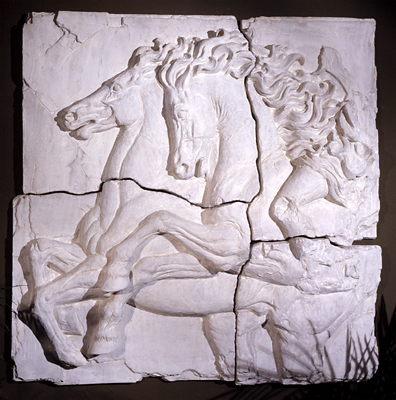What are "Basic" Aids?

Where did your horse come from?
It seems like a silly question, but when one considers the possible answers, one is struck by the different circumstances young foals are born into. Some are range foals, born on the prairie to a community of horses, harvested at fall round-up, and introduced to humans--and confinement--in a rather abrupt manner. Others, born in the confinement of a stall and imprinted within hours of birth, never know a time when humans are not a part of their lives. You may or may not have been present at your horse’s “Human 101” class, but you are certainly living with the resulting impressions and lasting behaviors from it. With any luck, you’re enjoying the fruits of a successful introduction……but what if you’re struggling with the negative effects of a less-than-ideal introduction? It’s not uncommon for riders to find themselves with a middle aged or mature horse, history unknown, trying to figure out how to correct some undesirable habits, or introduce new behaviors. Where does one start? At the beginning, with the introduction of the basic aids.
A horse born to a domestic environment, versus a wild environment, has an equal necessity to be educated to the basic aids. Too often, “tamed” and “trained” are used indiscriminately. A “barn baby” may be considered safe, because he does not fear or defend himself against humans. A “range colt” may be intimidating, because he has not yet learned to trust humans and yield to their requests. However, each young horse is equally capable of becoming a valued partner, learning about and complying with the requests of their human counterparts. Each young horse, regardless of its birth, has a desire to feel safe and make sense of the requests being made of it.
Perhaps the most under-rated subject a horse could learn is basic halter training. It is often approached hastily, in a desire to move onto more interesting, more “productive” work. Halter training is one of the responsibilities of the apprentice at large training facilities. It’s generally passed off onto the youngest, most inexperienced, and least educated hand on the outfit. Overlooked is the fact that what the horse learns during halter training, at the end of the lead rope, is what determines the quality of the rides to come. It is at this precious time the horse learns to respond to the release of pressure. The tact of the request--and subsequent release--is crucial to the horse’s understanding of the aids.
Halter training instigates the introduction of the most basic of the aids, the direct rein. Here’s the good news: all horses already know it. It’s a natural response for the horse to rotate his hind legs around the rein (lead rope) indication. A left direct rein request results in the horse moving his hindquarters to the right. A right direct rein request results in the horse moving his hindquarters to the left. This basic aid allows a rider to indicate to the horse to transfer his weight onto his front end, so he may pick up and move his rear end.
The indirect rein is a trained effect. While it does require some practice, it is generally not a difficult concept for the horse. A left indirect rein request, correctly executed, will ask the horse to change his posture in such a way as to make it possible to pick up his front feet and move right. A right indirect rein request would indicate to the horse to change his posture to move his front feet to the left. A well-executed indirect rein indication should have the effect of weighing the horse’s rear end, and freeing his front end for movement. Direct and indirect aids indicate to the horse to turn, or pivot, in a circle around a point.
Also considered basic aids are the half halt and the reverse half halt, which indicate either a shortening or lengthening of the base of the feet, respectively. These can be used to indicate forward or backward movement, and also should be trained during initial halter training. Within these four basic rein aids lie all possible postures, positions, and subsequent movements. They can be introduced with a halter and refined with a snaffle bit, and can be used to indicate everything from basic movements to fantasy equitation. Actually, fantasy equitation IS basic equitation….executed with extraordinary care.
It seems like a silly question, but when one considers the possible answers, one is struck by the different circumstances young foals are born into. Some are range foals, born on the prairie to a community of horses, harvested at fall round-up, and introduced to humans--and confinement--in a rather abrupt manner. Others, born in the confinement of a stall and imprinted within hours of birth, never know a time when humans are not a part of their lives. You may or may not have been present at your horse’s “Human 101” class, but you are certainly living with the resulting impressions and lasting behaviors from it. With any luck, you’re enjoying the fruits of a successful introduction……but what if you’re struggling with the negative effects of a less-than-ideal introduction? It’s not uncommon for riders to find themselves with a middle aged or mature horse, history unknown, trying to figure out how to correct some undesirable habits, or introduce new behaviors. Where does one start? At the beginning, with the introduction of the basic aids.
A horse born to a domestic environment, versus a wild environment, has an equal necessity to be educated to the basic aids. Too often, “tamed” and “trained” are used indiscriminately. A “barn baby” may be considered safe, because he does not fear or defend himself against humans. A “range colt” may be intimidating, because he has not yet learned to trust humans and yield to their requests. However, each young horse is equally capable of becoming a valued partner, learning about and complying with the requests of their human counterparts. Each young horse, regardless of its birth, has a desire to feel safe and make sense of the requests being made of it.
Perhaps the most under-rated subject a horse could learn is basic halter training. It is often approached hastily, in a desire to move onto more interesting, more “productive” work. Halter training is one of the responsibilities of the apprentice at large training facilities. It’s generally passed off onto the youngest, most inexperienced, and least educated hand on the outfit. Overlooked is the fact that what the horse learns during halter training, at the end of the lead rope, is what determines the quality of the rides to come. It is at this precious time the horse learns to respond to the release of pressure. The tact of the request--and subsequent release--is crucial to the horse’s understanding of the aids.
Halter training instigates the introduction of the most basic of the aids, the direct rein. Here’s the good news: all horses already know it. It’s a natural response for the horse to rotate his hind legs around the rein (lead rope) indication. A left direct rein request results in the horse moving his hindquarters to the right. A right direct rein request results in the horse moving his hindquarters to the left. This basic aid allows a rider to indicate to the horse to transfer his weight onto his front end, so he may pick up and move his rear end.
The indirect rein is a trained effect. While it does require some practice, it is generally not a difficult concept for the horse. A left indirect rein request, correctly executed, will ask the horse to change his posture in such a way as to make it possible to pick up his front feet and move right. A right indirect rein request would indicate to the horse to change his posture to move his front feet to the left. A well-executed indirect rein indication should have the effect of weighing the horse’s rear end, and freeing his front end for movement. Direct and indirect aids indicate to the horse to turn, or pivot, in a circle around a point.
Also considered basic aids are the half halt and the reverse half halt, which indicate either a shortening or lengthening of the base of the feet, respectively. These can be used to indicate forward or backward movement, and also should be trained during initial halter training. Within these four basic rein aids lie all possible postures, positions, and subsequent movements. They can be introduced with a halter and refined with a snaffle bit, and can be used to indicate everything from basic movements to fantasy equitation. Actually, fantasy equitation IS basic equitation….executed with extraordinary care.
9.30.11 TME
return to
Educated Equestrian
return to
Educated Equestrian

"Finally should be mentioned the correct execution of this art mainly depends on that the rider does not act as if he thinks the horse is able to read his mind, and in reliance on the horse’s intellect spends more time on really teaching the horse the aids. The training is based on conveying to the horse the meaning of the aids, becoming the master of the horse’s will and accustoming the horse’s memory." Adam Ehrengranat, 1781-1842, Swedish equerry and manager of Sweden’s Flyinge Stud Farm
A horse who is clear on the meaning of the aids, and has committed them to memory, is a pleasure to ride. He is confidant and brave, assured by the consistency of his human counterpart. He resists seldom, as he is seldom confused by the requests made of him. The educated equestrian may not ever be able to guess the details of the past of the horse before him, but with an understanding of the basic aids, has one of the necessary tools for shaping the future.